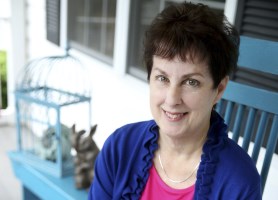A veteran speaker and writing teacher, Candice Ransom has given hundreds of presentations to schools, libraries, conferences, and literary festivals. In addition to writing and speaking, she currently teaches in the Hollins University graduate children’s literature program. Her education includes an MFA in writing for children from Vermont College of Fine Arts, and an MA in children’s literature from Hollins University.
Candice’s programs are supplemented by PowerPoint, peppered with enthusiastic discussions and stories about the writing life from someone who started writing when she was seven, decided to be a writer when she was ten, and began writing children’s books for publication when she was fifteen after that, it was a longer road than she imagined!
“Writing Magic . . . and Keeping It Real”
Who doesn’t love magic? Who doesn’t want to try writing magic? In this program, Candice will focus on how magical elements in her latest middle grade are rooted in realism. From finding the setting for Morning Glory (fictional town, real place—three years of searching) to giving the ghost characters a reason for staying on earth, students will understand that writing magic isn’t just “making up stuff.” To make it believable, it needs to make sense. This is achieved through place, character’s backgrounds, history, and, in Juneberry Blue, local folklore and traditions. Juneberry Blue took nine years from Candice’s initial idea to the book in her hands. Candice will show slides of ordinary objects and places that inspired her to add a sparkle of magic to her book. Grades 4 – 6. PowerPoint, 50 minutes.
The Big Green Pocketbook, Amanda Panda Quits Kindergarten, Amanda Panda and the Bigger, Better Birthday
Three autobiographical picture books—one based on a fun day with Candice and her mother, one based loosely on her first day of school, and the last based on rivalry with her cousin—help young children realize it’s okay to write “what you know.” Grades K-1. PowerPoint, 45 minutes.
Emus, Monster Trucks, Salamanders, and The Worst Cat in the World
This program focuses on Candice’s experiences in writing true stories (50+ nonfiction titles) and the importance of writing what you don’t know. Candice knew nothing about monster trucks or endangered frogs when she wrote books on those topics. Students will learn how to ferret out true stories on the Internet, then dig deeper with books, articles, local travel, and interviews. Grades 2-6. PowerPoint, 50 minutes.
Thomas Jefferson: Author of the Declaration of Independence, President, Paleontologist?
This program focuses on Candice’s nonfiction picture book, Bones in the White House: Thomas Jefferson’s Mammoth. Students will learn how one sentence in a book led Candice on a three-year journey that encompassed Ice Age mammals, the New Republic’s struggle to gain foothold on the world stage, 18th century natural history, and Jefferson’s keen interest in all sciences. Candice will discuss her first mistake in research (assuming Jefferson’s papers are in one place and the public can access them), and how she pieced together a story from many resources, like a detective following clues. Students will see a different side of Jefferson and realize research can take them to wonderful, unknown places. They’ll also see Candice’s edited drafts and photos from her travels, including an old Ice Age dig site. Grades 2-6. PowerPoint, 50 minutes.
Goodnight Room: Writing List Poetry
This program/workshop focuses on Candice’s nonfiction picture book, Only Margaret: A Story about Margaret Wise Brown. Students will be introduced to the author of over a hundred picture books, and how Candice’s book took nineteen years, from idea to published book, through the persistence of revision. Then Candice will guide students through writing poems based on Margaret Wise Brown’s most well-known picture book, Goodnight Moon, and The Friendly Book, both of which use a list structure. Grades 2-4. PowerPoint, 50 minutes.

